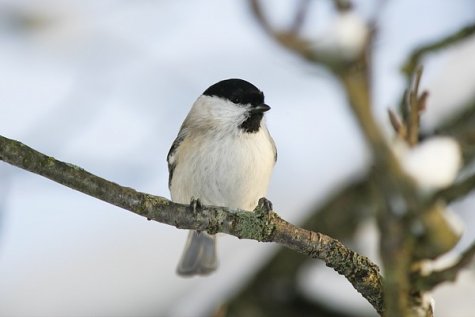Bird feeder life
Text: Andrus Jair
Photo: Arne Ader
Translation: Liis
Marsh tit.
Bird feeders are hot spots for all kinds of birds. The severe winter has made keeping alive complicated for them. But at the same time we suddenly have the chance to see surprising kinds of birds outside our own home windows. In addition to all feeding on fat and seeds, the bird feeders are visited by various birds of prey. Meeting them ever so often in our home backyard leaves mixed feelings. Human psychology is interesting!
The tits are the ever-loved pets, they are praised for their well brought up manners in coming to the feeder, picking a sunflower seed and leaving at once for a nearby bush where they start eating the catch. The table manners of sparrows and greenfinches aren’t so much praised, they arrive and won’t leave until they have stuffed themselves completely full in the feeder.
The marsh tit is praised too – it works like a cleaner around the bird feeder – first searching for spilled seeds on the ground, and only when there is nothing more to find it flies up to the feeder.
The jays that in this thick snow probably can’t get at their acorns, carefully hidden in autumn, are splendid to watch too, “really good lookers”.
And oh for the times that partridges come to visit: that makes for cooing and fluttering among us humans, there is no end to the loving admiration for these lovable, cuddly, round birds.
The sparrowhawk is a different matter, beautiful bird, but slays other nice birds, look here, it even kills those plucky tits, it is a pest. And it doesn’t leave either, when you open the window and clap your hands. The grey shrikes probably get a less bad rating – oh well, Bird of the Year, it can have a tit or two.
The hen harrier comes to catch domestic pigeons; that isn’t seen as so condemnable, pigeons aren’t as lovable as tits.
So the sparrowhawk is the worst of evildoers.
Yesterday my mother called to tell that outside the windows of an apartment house in Valgu village in Märjamaa an owl came to catch tits. The apartment folks described the bird roughly as yellow eyed, with a square head, and nearly without tail, a short little stump of a bird, but it slayed birds like a demon. They had shown a rough size measure too, according to mother around 10-12 centimetres. The people had already checked up on some owls and proposed that it could be a pygmy owl. Not a bad guess, it may well be a pygmy owl, forced by hunger into the settled area. On the whole I have tried to calm people down and asked them – figuratively – to reach for a camera rather than a gun. It should be splendid to be able to follow the doings of a bird of prey outside one’s window until spring; certainly not all of them will manage to survive throughout this severe winter:
See Danish photos









